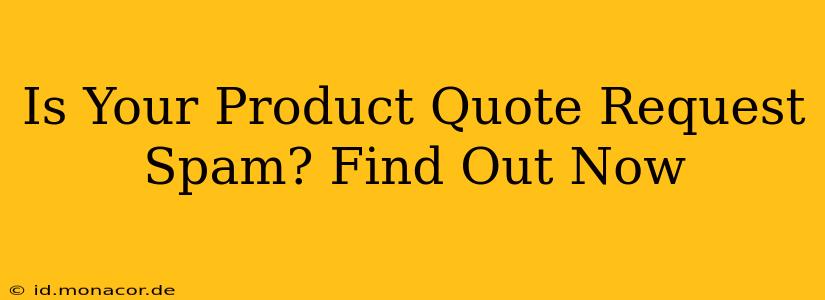In today's digital landscape, navigating the deluge of online communications can be a challenge. One common concern for businesses is discerning legitimate product quote requests from spam. Misidentifying these can lead to wasted time, missed opportunities, or even security risks. This comprehensive guide will help you identify suspicious quote requests and implement strategies to protect your business.
What Makes a Product Quote Request Suspicious?
Several red flags can indicate a potentially fraudulent or spam quote request. Let's explore the most common indicators:
-
Generic or Automated Inquiries: Legitimate requests often contain specific details about the product or service needed. Spam emails, on the other hand, frequently use generic greetings and lack personalized information. Be wary of requests that seem mass-produced and lack specific details about your products or services.
-
Unusual Email Addresses or Domains: Suspicious emails may originate from free email providers (like Gmail or Yahoo) or use domains that look similar to legitimate businesses but have subtle differences. Check the sender's email address carefully for inconsistencies.
-
Poor Grammar and Spelling: While not always a definitive indicator, frequent grammatical errors and spelling mistakes often suggest an automated or hastily created message.
-
Urgent or Pressuring Language: Spam emails frequently use high-pressure tactics, demanding immediate responses or creating a false sense of urgency. Legitimate businesses generally allow for a reasonable timeframe for responses.
-
Requests for Unusual Information: Be wary of requests that seem excessive or demand information that isn't strictly necessary for a quote. Legitimate businesses will only request information directly related to the quote.
-
Lack of Contact Information: Legitimate businesses usually provide various contact details—phone numbers, addresses, etc.—making it easy for you to verify their authenticity. A lack of contact information should raise suspicion.
-
Suspicious Attachments: Never open attachments from unknown senders. These attachments could contain malware or viruses that can harm your computer system.
How Can I Verify a Product Quote Request?
Once you've identified a potentially suspicious request, several steps can help you verify its authenticity:
1. Verify the Sender's Identity:
Try to find the company online. Check their website, social media profiles, and online reviews to see if they exist and have a legitimate presence.
2. Reverse Phone Lookup (If Provided):
If a phone number is included, use a reverse phone lookup service to verify if the number belongs to the claimed company.
3. Check for Online Reviews:
Look for online reviews of the company. Negative reviews or a lack of reviews can indicate potential problems.
4. Contact the Company Directly (Using Verified Contact Information):
If you have doubts, try contacting the company through a verified phone number or email address found on their official website. Ask about the quote request. A legitimate business will happily confirm the inquiry.
Is a Lack of Detail Always a Bad Sign?
Not necessarily. Sometimes, a request might lack detail due to the client's unfamiliarity with the specifics or the product's complexity. However, the lack of detail should be combined with other indicators mentioned above to arrive at a conclusive decision. A well-structured, professional email, even if lacking detail, might still be genuine.
What Should I Do If I Suspect a Spam Quote Request?
If you strongly suspect a quote request is spam, report the email to your email provider and delete it without opening any attachments. Don't respond to the request. Implementing strong spam filters can also help prevent similar emails from reaching your inbox.
By carefully examining the details and using the verification methods outlined above, you can effectively distinguish between legitimate product quote requests and spam, protecting your business from potential threats and ensuring you focus your time on real opportunities.

